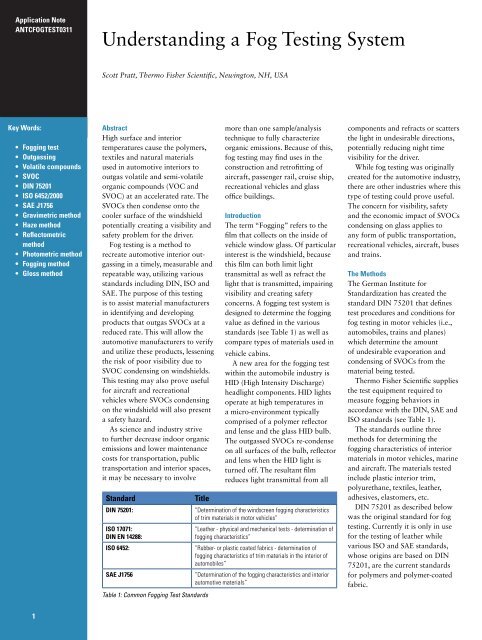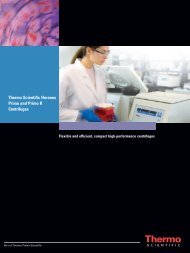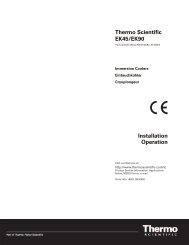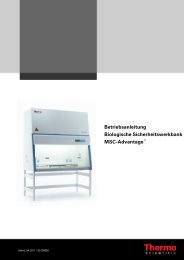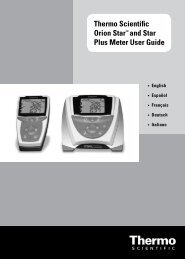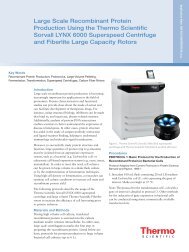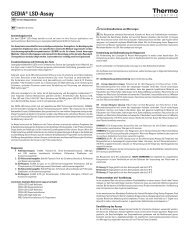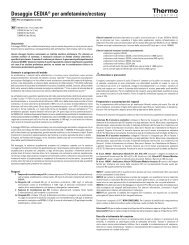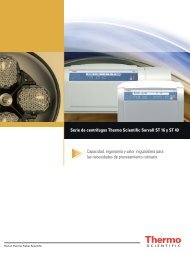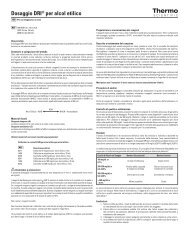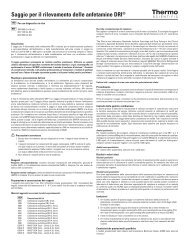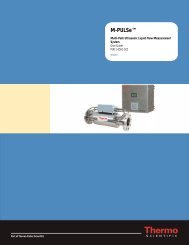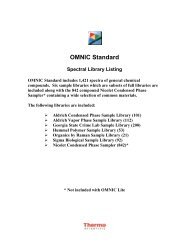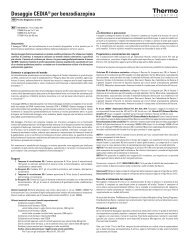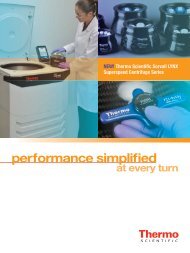Understanding a Fog Testing System - Thermo Scientific
Understanding a Fog Testing System - Thermo Scientific
Understanding a Fog Testing System - Thermo Scientific
You also want an ePaper? Increase the reach of your titles
YUMPU automatically turns print PDFs into web optimized ePapers that Google loves.
Application Note<br />
ANTCFOGTEST0311<br />
Key Words:<br />
• <strong>Fog</strong>ging test<br />
• Outgassing<br />
• Volatile compounds<br />
• SVOC<br />
• DIN 75201<br />
• ISO 6452/2000<br />
• SAE J1756<br />
• Gravimetric method<br />
• Haze method<br />
• Reflectometric<br />
method<br />
• Photometric method<br />
• <strong>Fog</strong>ging method<br />
• Gloss method<br />
1<br />
<strong>Understanding</strong> a <strong>Fog</strong> <strong>Testing</strong> <strong>System</strong><br />
Scott Pratt, <strong>Thermo</strong> Fisher <strong>Scientific</strong>, Newington, NH, USA<br />
Abstract<br />
High surface and interior<br />
temperatures cause the polymers,<br />
textiles and natural materials<br />
used in automotive interiors to<br />
outgas volatile and semi-volatile<br />
organic compounds (VOC and<br />
SVOC) at an accelerated rate. The<br />
SVOCs then condense onto the<br />
cooler surface of the windshield<br />
potentially creating a visibility and<br />
safety problem for the driver.<br />
<strong>Fog</strong> testing is a method to<br />
recreate automotive interior outgassing<br />
in a timely, measurable and<br />
repeatable way, utilizing various<br />
standards including DIN, ISO and<br />
SAE. The purpose of this testing<br />
is to assist material manufacturers<br />
in identifying and developing<br />
products that outgas SVOCs at a<br />
reduced rate. This will allow the<br />
automotive manufacturers to verify<br />
and utilize these products, lessening<br />
the risk of poor visibility due to<br />
SVOC condensing on windshields.<br />
This testing may also prove useful<br />
for aircraft and recreational<br />
vehicles where SVOCs condensing<br />
on the windshield will also present<br />
a safety hazard.<br />
As science and industry strive<br />
to further decrease indoor organic<br />
emissions and lower maintenance<br />
costs for transportation, public<br />
transportation and interior spaces,<br />
it may be necessary to involve<br />
Standard Title<br />
more than one sample/analysis<br />
technique to fully characterize<br />
organic emissions. Because of this,<br />
fog testing may find uses in the<br />
construction and retrofitting of<br />
aircraft, passenger rail, cruise ship,<br />
recreational vehicles and glass<br />
office buildings.<br />
Introduction<br />
The term “<strong>Fog</strong>ging” refers to the<br />
film that collects on the inside of<br />
vehicle window glass. Of particular<br />
interest is the windshield, because<br />
this film can both limit light<br />
transmittal as well as refract the<br />
light that is transmitted, impairing<br />
visibility and creating safety<br />
concerns. A fogging test system is<br />
designed to determine the fogging<br />
value as defined in the various<br />
standards (see Table 1) as well as<br />
compare types of materials used in<br />
vehicle cabins.<br />
A new area for the fogging test<br />
within the automobile industry is<br />
HID (High Intensity Discharge)<br />
headlight components. HID lights<br />
operate at high temperatures in<br />
a micro-environment typically<br />
comprised of a polymer reflector<br />
and lense and the glass HID bulb.<br />
The outgassed SVOCs re-condense<br />
on all surfaces of the bulb, reflector<br />
and lens when the HID light is<br />
turned off. The resultant film<br />
reduces light transmittal from all<br />
DIN 75201: “Determination of the windscreen fogging characteristics<br />
of trim materials in motor vehicles”<br />
ISO 17071:<br />
DIN EN 14288:<br />
“Leather - physical and mechanical tests - determination of<br />
fogging characteristics”<br />
ISO 6452: “Rubber- or plastic coated fabrics - determination of<br />
fogging characteristics of trim materials in the interior of<br />
automobiles”<br />
SAE J1756 “Determination of the fogging characteristics and interior<br />
automotive materials”<br />
Table 1: Common <strong>Fog</strong>ging Test Standards<br />
components and refracts or scatters<br />
the light in undesirable directions,<br />
potentially reducing night time<br />
visibility for the driver.<br />
While fog testing was originally<br />
created for the automotive industry,<br />
there are other industries where this<br />
type of testing could prove useful.<br />
The concern for visibility, safety<br />
and the economic impact of SVOCs<br />
condensing on glass applies to<br />
any form of public transportation,<br />
recreational vehicles, aircraft, buses<br />
and trains.<br />
The Methods<br />
The German Institute for<br />
Standardization has created the<br />
standard DIN 75201 that defines<br />
test procedures and conditions for<br />
fog testing in motor vehicles (i.e.,<br />
automobiles, trains and planes)<br />
which determine the amount<br />
of undesirable evaporation and<br />
condensing of SVOCs from the<br />
material being tested.<br />
<strong>Thermo</strong> Fisher <strong>Scientific</strong> supplies<br />
the test equipment required to<br />
measure fogging behaviors in<br />
accordance with the DIN, SAE and<br />
ISO standards (see Table 1).<br />
The standards outline three<br />
methods for determining the<br />
fogging characteristics of interior<br />
materials in motor vehicles, marine<br />
and aircraft. The materials tested<br />
include plastic interior trim,<br />
polyurethane, textiles, leather,<br />
adhesives, elastomers, etc.<br />
DIN 75201 as described below<br />
was the original standard for fog<br />
testing. Currently it is only in use<br />
for the testing of leather while<br />
various ISO and SAE standards,<br />
whose origins are based on DIN<br />
75201, are the current standards<br />
for polymers and polymer-coated<br />
fabric.
<strong>Fog</strong>ging Behavior DIN 75201<br />
Reflectometric method, photometric<br />
method, fogging method, gloss method<br />
According to this method, a<br />
prepared sample is placed in a<br />
beaker that is then covered with a<br />
glass plate. The plate’s Reflective<br />
Index has been measured and<br />
recorded using a handheld<br />
reflectometer. For a period of<br />
three hours the sample is heated<br />
to 100°C, while the glass plate is<br />
cooled to 21°C. The heat causes<br />
the sample to release SVOC gasses<br />
that condense on the cooled glass<br />
plate creating a “<strong>Fog</strong>” (F). The<br />
Reflective Index of the fogged glass<br />
is measured and recorded.<br />
<strong>Fog</strong>ging value (Fv) is expressed<br />
as a percent of change in the 60°<br />
Reflective Index of a glass plate<br />
that has been fogged in accordance<br />
with the procedures (R1) to a clean<br />
glass plate (R2).<br />
Fv = (R2 x 100)/R1<br />
Where:<br />
Fv = <strong>Fog</strong>ging value<br />
R1 = the mean initial reflective<br />
index of the glass plate with the<br />
fogging condensate<br />
R2 = the mean initial reflective<br />
index of the glass plate<br />
DIN specifies the maximum<br />
value for Fv in this test at 90%.<br />
Test Method Standard<br />
<strong>Fog</strong>ging Behavior DIN 75201<br />
Gravimetric method<br />
According to this method, a<br />
prepared sample is placed in a<br />
beaker that is then covered with<br />
an aluminium foil disk. The disk’s<br />
mass has been measured and<br />
recorded. For a period of sixteen<br />
hours the sample is heated to<br />
100°C, while the aluminium foil<br />
disk is cooled to 21°C. The heat<br />
causes the sample to release SVOC<br />
gasses that condense on the cooled<br />
aluminium foil disk creating a<br />
“<strong>Fog</strong>” (F) that has a measurable<br />
mass (m). The amount of fogging<br />
condensate is determined by<br />
weighing the aluminium foil disk<br />
again after the test and subtracting<br />
the known mass of the same<br />
aluminium foil disk before fogging.<br />
mF = m2 – m1<br />
mF = the mass of the fog<br />
condensate collected during the test<br />
m1 = the initial mass of the disc<br />
of aluminum foil (milligrams)<br />
m2 = the mass of the disc of<br />
aluminum foil with the fogging<br />
condensate (milligrams)<br />
This is the preferred method<br />
because the longer run time and<br />
simple measurements increase<br />
accuracy while minimizing errors<br />
inherent in the reflectometric<br />
method such as contaminated or<br />
damaged glass, using the incorrect<br />
side of the glass, or errors in<br />
measuring the reflective index.<br />
Gravimetric DIN 75201-B; ISO 17071; DIN EN 14288-B; ISO 6452-B;<br />
SAE J 1756:<br />
PV 3015<br />
GME 60326-A; GMW 3235-B:<br />
TSM05036-B:<br />
D45 1727<br />
Reflective DIN 75201-A; DIN EN 14288-A; ISO 6452-A:<br />
PV 3015; PV 3920:<br />
TSM05036-B; D45 1727<br />
Haze-measurement DIN 75201-A:<br />
HES D6508-95<br />
MS 300-54<br />
Table 2: <strong>Fog</strong>ging test standards & methods used by automotive manufacturers<br />
Horizon <strong>Fog</strong> <strong>Testing</strong> <strong>System</strong> with<br />
Accel 250 LC Laboratory Chiller<br />
<strong>Fog</strong>ging Behavior DIN 75201-A<br />
Haze method<br />
The hazing method uses the same<br />
process as the reflectometric but<br />
instead of measuring the Reflective<br />
Index of the glass, a haze meter is<br />
used. The haze meter measures the<br />
light transmission through the glass<br />
plate both before and after the<br />
fogging process.<br />
It is worth noting that the<br />
proprietary standards of individual<br />
companies often use different<br />
temperatures and time periods to<br />
achieve specific results. (See Table 2).<br />
Conclusion<br />
The German Institute for<br />
Standardization worked with<br />
<strong>Thermo</strong> Fisher <strong>Scientific</strong> to develop<br />
the fogging test equipment used<br />
in the DIN 75-201 standard<br />
that determines the out gassing<br />
of materials in motor vehicles.<br />
Over the years, derivatives of<br />
this standard have been created<br />
and are now used in various<br />
industries. Because of the<br />
consistent, repeatable results of<br />
the <strong>Thermo</strong> <strong>Scientific</strong> Horizon<br />
<strong>Fog</strong>ging Test <strong>System</strong>, it continues<br />
to be the equipment of choice for<br />
every standard. While the effort<br />
to clean an individual automotive<br />
windshield is minimal, creating,<br />
identifying and utilizing materials<br />
that emit SVOCs at a reduced rate<br />
is key to public safety, reduced<br />
maintenance expenses, and the<br />
customer perception of a quality<br />
product.<br />
ANTCFOGTEST0311<br />
In addition to these offices,<br />
<strong>Thermo</strong> Fisher <strong>Scientific</strong><br />
maintains a network of<br />
representative organizations<br />
throughout the world.<br />
Benelux<br />
Tel. +31 (0) 76 579 55 55<br />
info.tc.nl@thermofisher.com<br />
China<br />
Tel. +81 3 5826 1616<br />
info.tc.china@thermofisher.com<br />
France<br />
Tel. +33 (0) 1 60 92 48 00<br />
info.tc.fr@thermofisher.com<br />
Germany<br />
Tel. +49 (0) 721 4 09 44 44<br />
info.tc.de@thermofisher.com<br />
India<br />
Tel. +91 (22) 27 78 11 01<br />
Contact.lpg.in@thermofisher.com<br />
Japan<br />
Tel. +81 45 453 9220<br />
info.lpg.jp@thermofisher.com<br />
USA<br />
Tel. 603 436 9444<br />
info.tc.us@thermofisher.com<br />
www.thermoscientific.com/tc<br />
© 2011 <strong>Thermo</strong> Fisher <strong>Scientific</strong> Inc.<br />
All rights reserved. All trademarks are<br />
the property of <strong>Thermo</strong> Fisher <strong>Scientific</strong><br />
and its subsidiaries. This document is<br />
for informational purposes only and is<br />
subject to change without notice.<br />
2


